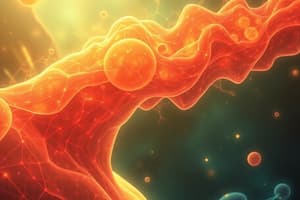Podcast
Questions and Answers
In primary hyperthyroidism, what is the primary issue?
In primary hyperthyroidism, what is the primary issue?
What is the most common cause of primary hyperthyroidism?
What is the most common cause of primary hyperthyroidism?
In secondary hyperthyroidism, what is the underlying cause?
In secondary hyperthyroidism, what is the underlying cause?
What is the role of TSH in hyperthyroidism?
What is the role of TSH in hyperthyroidism?
Signup and view all the answers
What is a 'functioning' tumor in the context of endocrine disorders?
What is a 'functioning' tumor in the context of endocrine disorders?
Signup and view all the answers
In tertiary hyperthyroidism, what is the affected gland?
In tertiary hyperthyroidism, what is the affected gland?
Signup and view all the answers
What is the role of TRH in the regulation of thyroid hormones?
What is the role of TRH in the regulation of thyroid hormones?
Signup and view all the answers
Which of the following correctly describes the relationship between TRH, TSH, and T3/T4?
Which of the following correctly describes the relationship between TRH, TSH, and T3/T4?
Signup and view all the answers
Study Notes
Hyperthyroidism Overview
- Hyperthyroidism is a condition where the thyroid gland produces excessive thyroid hormones (T3 and T4), leading to a hypermetabolic state in the body.
- Similar to hypothyroidism, hyperthyroidism has primary, secondary, and tertiary causes.
Hormone Regulation
- Thyroid hormone production involves a chain reaction:
- Hypothalamus releases thyroid-releasing hormone (TRH).
- Pituitary gland releases thyroid-stimulating hormone (TSH).
- Thyroid gland produces T3 and T4.
Pathophysiology: Understanding the Different Types
-
To understand the types of hyperthyroidism, analyze the hormone chain in reverse.
- Start with the thyroid and follow the process backward.
-
Primary hyperthyroidism:
- Results from a problem directly within the thyroid gland itself.
- Most common cause is Graves' disease, an autoimmune disorder where antibodies cause the thyroid to enlarge and overproduce hormones.
- Thyroid nodules (small tumors) can also cause primary hyperthyroidism.
-
Secondary hyperthyroidism:
- Resulting from a problem in the pituitary gland, commonly a tumor called a functioning tumor.
- The pituitary gland releases excessive TSH.
- Excess TSH prompts the thyroid, which is just following orders to make more hormones.
-
Tertiary hyperthyroidism:
- Results from a hypothalamus problem.
- Excessive TRH production, in turn, leads to increased TSH production.
- This again causes the thyroid to overproduce T3 and T4.
Studying That Suits You
Use AI to generate personalized quizzes and flashcards to suit your learning preferences.
Description
This quiz provides a comprehensive overview of hyperthyroidism, including its causes, hormone regulation, and types. It explores the role of the thyroid gland and the hypothalamus-pituitary-thyroid axis. Test your understanding of this hypermetabolic condition and its mechanisms.




